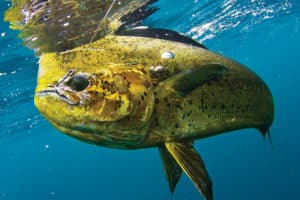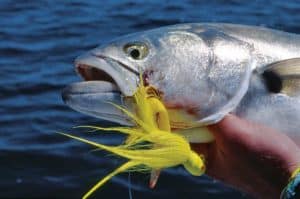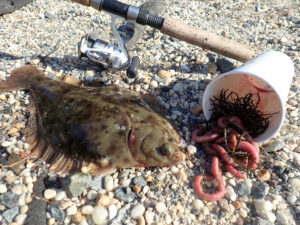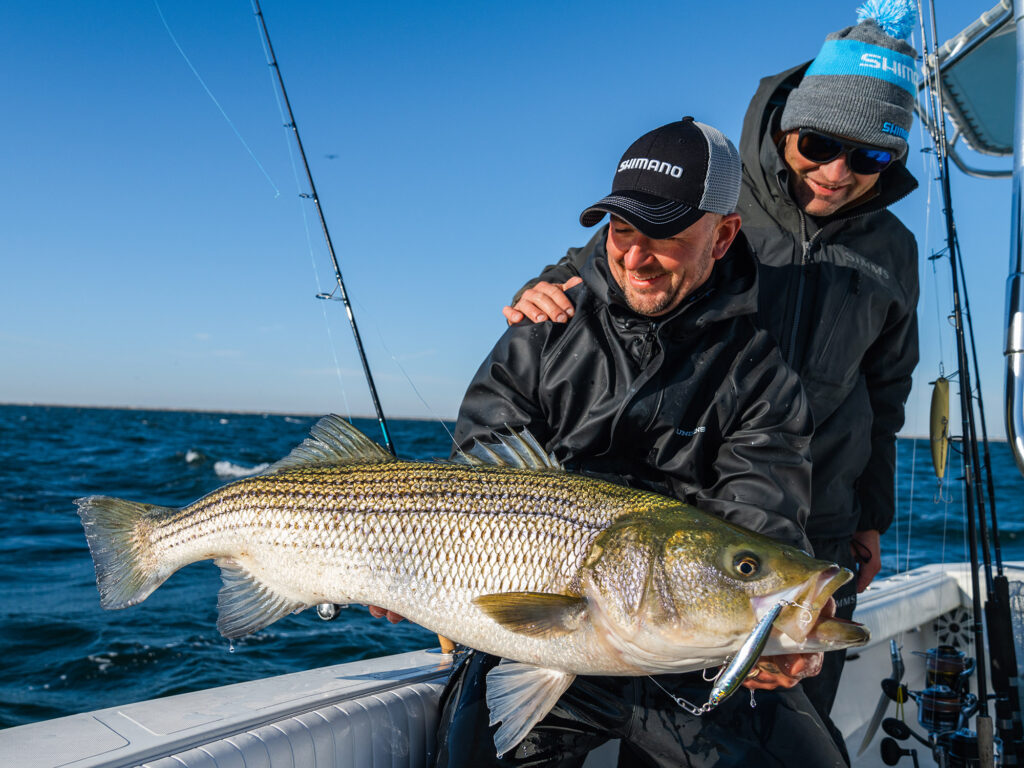
Like any sport, you can spend as much as you want gearing up for your next saltwater battle. However, northeast striper ace Blaine Anderson said the summer months offer plenty of opportunity for anglers with even modest tackle to engage one the region’s premier sport fish.
“It’s easy fishing and there’s a low barrier to entry,” Anderson said of the warm season’s incredible action. “They’re aggressive fish and you can catch them all summer long.”
The striper show abounds throughout this renowned region, with perennial favorites like Block Island (Rhode Island), Fishers Island (New York), Plum Island (Massachusetts) and countless reef systems such as Connecticut’s Bartlett Reef. Where current swirls through rock structure, Anderson expects his prime opportunities.
“Any of the reefs in 15 feet or less will produce, but a boat with a trolling motor will allow you to get in shallow,” Anderson said. “I’ll get in there as shallow as 3 to 4 feet. You have to be careful, because there are a lot of big boulders, but that’s what’s holding the stripers there.”
No doubt, the shallowest of these rocky minefields demand respect, so proceed with caution. Often, the reward more than justifies the effort. Just know that the attraction is all about feeding. Bunker (menhaden) and other forage are no match for the ocean’s might, but stripers are built for this.
“It’s a lot like trout in a river or a stream; the stripers will be in the eddy behind a boulder waiting for something to come by,” Anderson said. “They’re really powerful swimmers, so they don’t mind the current, but the bait is very vulnerable and they’re going to be swept across [the boulder field] and they’re at the mercy of the current at that time.
“Somedays, you may not see the bait, but other days, it may be all over and the stripers will be blowing up. It will change from one day to the next, but they will always be on the reefs and the more bait there is, the more active they are.”
Best Time to Fish for Stripers
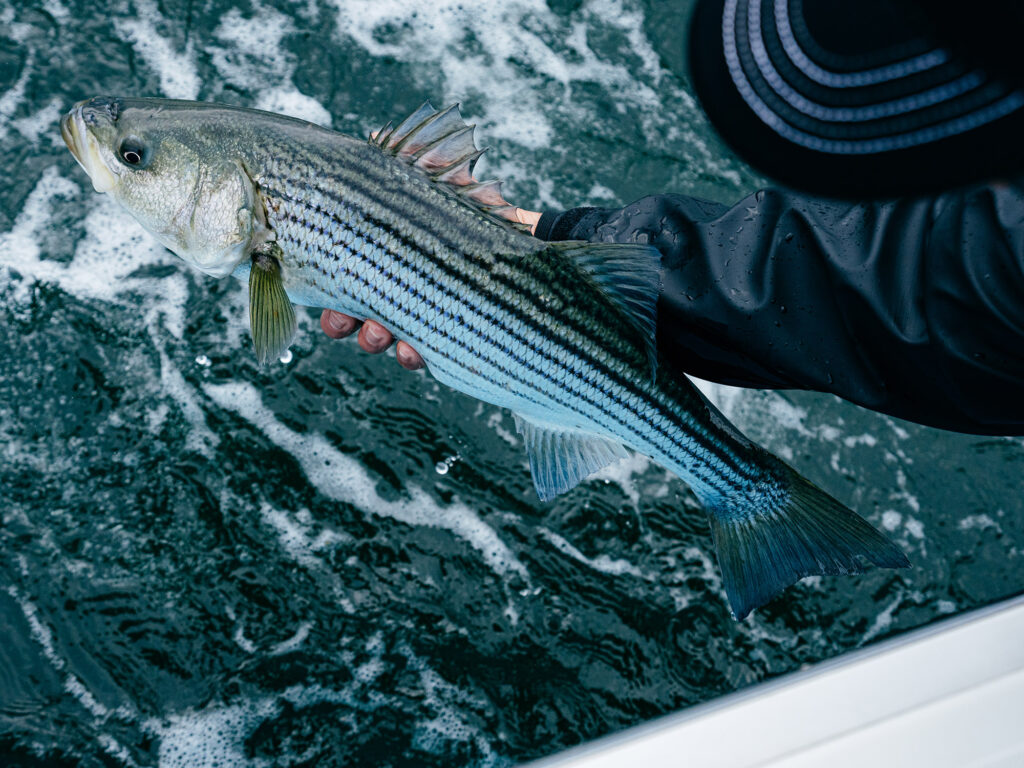
Anderson said the fish will feed in practically any summer conditions, but he likes a calm, overcast day — maybe even a little fog. It’s as much a mood thing as it is a fishing thing, but the ambiance is undeniable.
“Everything is so quiet; you can hear fish blow up from a distance,” Anderson said. “With calm water, I think the fish can hear the rattles in your (artificial) baits, so they can home in on it a little easier.
As for time of day, Anderson calls summer striper fishing a 24/7 adrenaline rush.
“Back in the day, when I was guiding, it didn’t matter what the weather was doing or what the tides were — we’d fish from 5 a.m. until 11,” Anderson said. “You can catch them at high noon, with not a cloud in the sky, but I prefer the low light of early morning, because you’re often the first one on your spot.
“A lot of boats can put the fish down, but if you get out there first, you can go really slow and quiet with the trolling motor and catch several before anyone gets out there.”
Lures and Tackle for Striped Bass
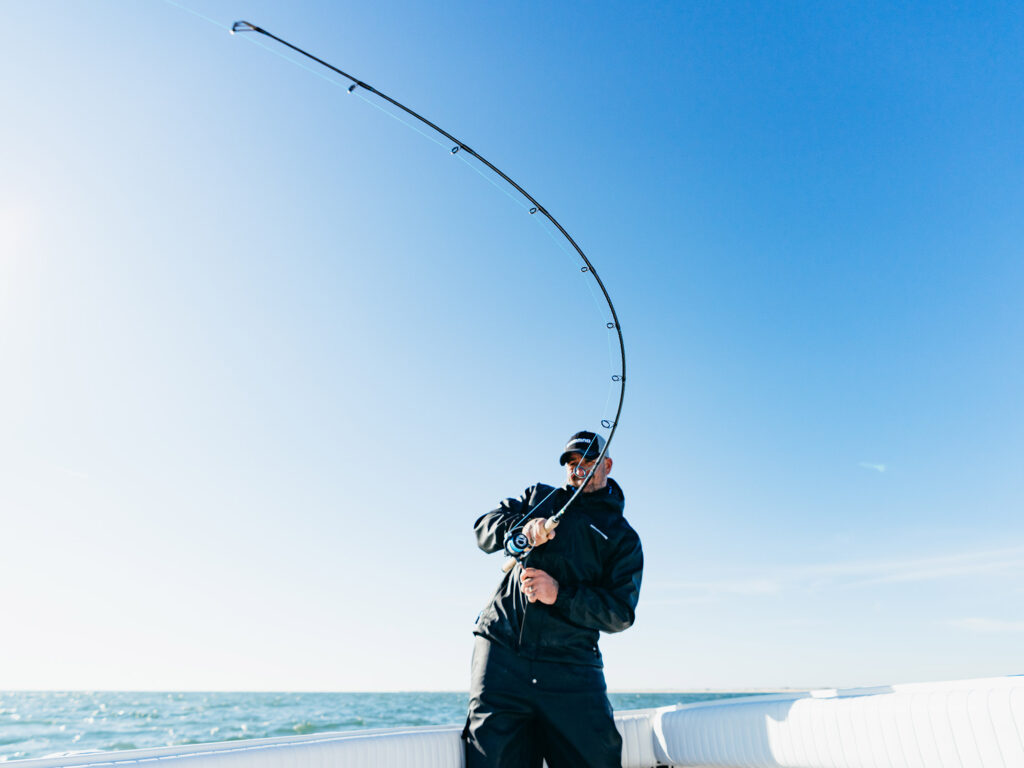
For simplicity and undeniable fish appeal, Anderson said it’s hard to beat a big 7- to 9-inch topwater walker. His preference, the Shimano Current Sniper Splash Walk in bone white or bunker.
“The topwater bites are explosive, but even if the fish are not being aggressive, those big topwaters will still call them up,” Anderson said. “After that, you can adjust to subsurface baits. These big topwater baits allow you to cover lot of water, but the nice thing about the Splash Walk is that with sharp rod twitches, you can almost walk it in place. You’re really only turning the handle of the reel to take the slack out of the line.
“Some days they want it a little different. Sometimes you’ll twitch it and let it sit there and they’ll come up and smash it on the pause. But if there are big fish around, you’re going to know it.”
Blaine Anderson’s Tackle Preferences: A 7-foot, 6-inch medium-heavy Shimano Terramar XX Southeast spinning rod with a Shimano Twinpower XD 4000 reel carrying 50-pound PowerPro Super Slick V2 braid and a 30- to 50-pound fluorocarbon leader.
“They’re not really line shy, but I’ll start with 4- to 5-foot leader, because as I change lures throughout the day, that leader gets shorter and shorter,” Anderson said. “For hook set and for pulling them out of boulder fields, this is a good setup.”
When he’s not finding the topwater action, one of Anderson’s go-tos is a jerkbait based on forage size. Top colors are herring, bone white, and white with colored spots. Another option is a large soft plastic twitchbait like a Lunker City Slug-Go or a Zoom Super Fluke. Anderson suggests rigging these baits on 4/0 to 5/0 belly-weighted hooks (or jig heads heavy enough for the water’s depth).
Live Bait Fishing for Striped Bass
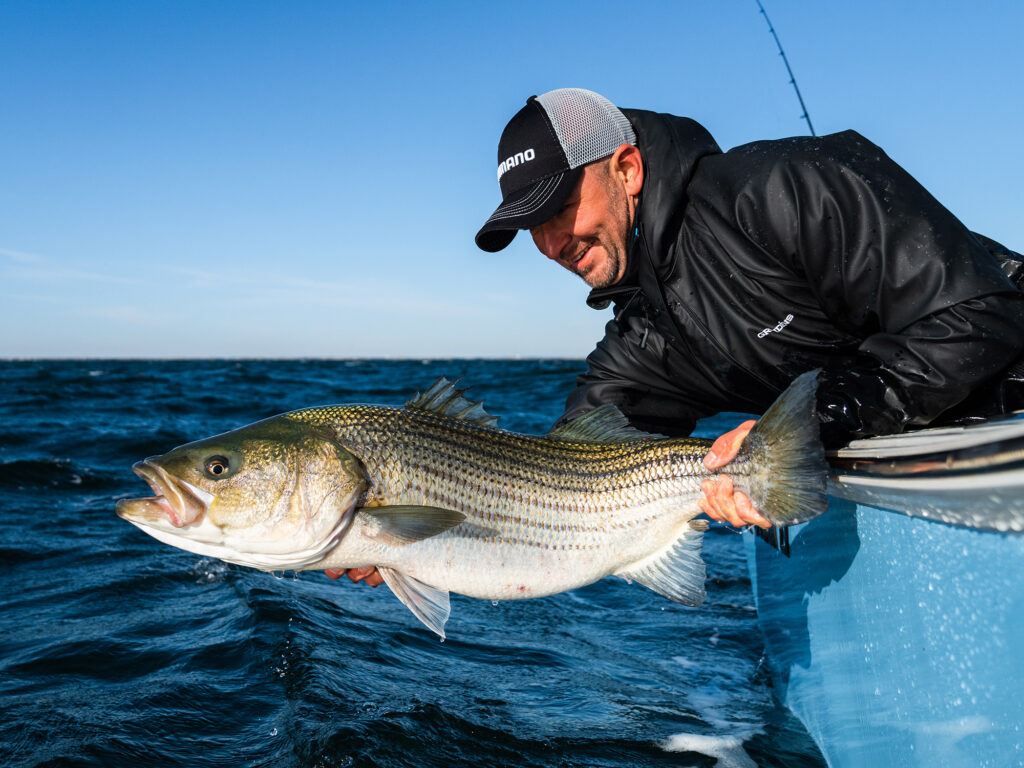
Complementing the lures, many Northeast stripers are caught on natural baits. Anderson says live eels are a Block Island favorite — especially after dark. Castnet a bunch of 12- to 14-inch bunker and you can catch stripers just about anywhere.
“The easiest way is to live line them on circle hooks in the same areas as you’d throw the topwaters,” Anderson said. “In deeper current areas, you’ll fish bunker on 3-way rigs with a heavy weight on the bottom. The trick is to keep it down and some days, you’ll need 16-ounce weights.”
Scup (aka porgies) also tempt stripers, but stow the castnet and catch these hardy bottom dwellers on hook and line. A dropper-style rig baited with squid or chunks of sand worm will deliver the goods. Then, rig scup on a bottom 3-way rig.
“If we’re live lining with no weight, I like to get up shallow and let the baits swim around the boulders,” Anderson said. “About 100 feet away is good, so when you hook up, you can change the angle on them to fight the fish out of the boulder field. With the 3-way rigs, the more vertical you can be the better. I like to fish live baits more up and down.”
Blaine Anderson’s Tackle Preferences: For live lining, a 7-foot, 6-inch medium-heavy Shimano Teramar XX Northeast casting rod with a Shimano Trinidad 12 or 14 reel spooled with 50-pound PowerPro Super Slick V2 braid. For 3-way rigging, a 7-foot medium-heavy casting rod with a Shimano Torium reel spooled with 50-pound PowerPro Super Slick V2 braid.
“If you’re going to be 3-way rigging, make sure your rod is stout enough to support the weight of whatever size sinker you’re using and still have enough backbone to fight the fish,” Anderson said. “You don’t want to strap a 16-ounce sinker on and watch the rod fully load before you get your bait in the water.”
However you engage summer stripers, Anderson describes the proper fighting style as a blend of patience and persistence. Summarily: Even pressure.
“I think the most common mistake is when people get excited and they’re pulling back on the rod too quickly so it’s fully loaded,” Anderson said. “When they make a couple of cranks and drop the rod tip, that rod is unloading and that’s when the hook ends up pulling. I like to have the same pressure on the rod whether I’m pulling on the fish or reeling down on the fish. The angle of the rod never changes.”


